POWER SYSTEMS RESEARCH LAB


Areas of Research
The main areas in which research is undertaken at our laboratory include:
- Power Systems
- Brain Signal Processing (Biomedical)
- Automation
- Industrial Automation
- Underwater Technologies
Final Year Projects
Automated Rover and Manipulator System (ARMS)
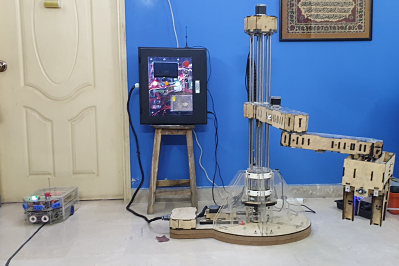
The aim of the project is to provide a cost-effective and feasible solution for automating the lifting and transport processes of heavy current transformers inside the company’s manufacturing facility.
Along with innovation, the project enables applied research comprising mechanical and electrical aspects. The solution proposed is an autonomous system to lift the transformers from ground level onto a motorized rover system capable of manoeuvring and transport the current transformers from the storage area to the assembly area. This will greatly mitigate the health and safety hazards and reduce worker fatigue and also increase the productivity of technicians. Process automation makes the work environment more ergonomically feasible and frees up time for the technician to carry out other tasks that require a greater level of human consideration. Robots and machines surpass the abilities of the human workforce in terms of speed, consistency and safety and enable Siemens Pakistan to pioneer industrial automation and robotics.
A scalable two-tier system with integrated communication was designed, developed and fabricated which includes a vision-guided Selective Compliance Articulated Robot Arm (SCARA) for lifting heavy loads and the Automated Guided Vehicle (AGV) for transporting goods inside an industrial facility. The prototype design stage comprised 3D modelling and joint torque analysis through CAD software, dynamic and part calculations analyzed using standard mechanical formulas. Moreover, control automation and computer vision algorithms were implemented for autonomous positioning, obstacle avoidance and grappling applications.
Transformer Health Monitoring System Using FPGA
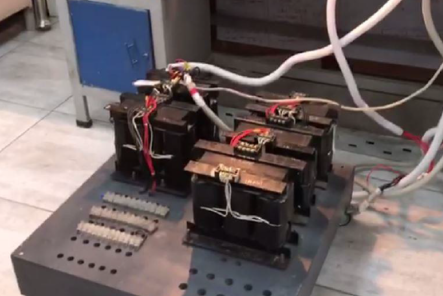
Transformers are essential and one of the most vital parts of the distribution and transmission device of electricity. Conditions primarily based on fitness tracking of electrical transformers for the troubles earlier than their incidence can save you the faults, which can be expensive to overtake and eventuate the lack of energy supply. Currently to be had structures reveal the fitness of transformers primarily based totally on DGA results. Along with being an essential part of the distribution and transmission network, transformers also are very expensive, as is the price of energy interruption.
The energy distribution businesses around the world are displaying extraordinary hobby in fitness tracking of transformers due to the fact fitness tracking can robustness, authenticity, providence, manufacturing and transmission feasibility of electrical power. Under the scope of this project, a device is being advanced that is capable of replicating the fitness of a transformer all through its operation the use of non-intrusive parameters, in order engineers can take right preventive measures earlier than minor troubles grow to be fundamental faults. Further, the signal processing and machine learning techniques are to be implemented in FPGA which later will be a complete autonomous device for this complete setup. In future, it is strictly advised to do so for the sake of reduced complexity, circuit size and requirement of extra equipment. For future aspects, it is advised that a deep and thorough learning of concepts of FPGA, principal component analysis (PCA), signal processing and communication networks is required in order to further move the current working. All these aspects are integrated in one place that gives a clear picture of what real-time and round the clock transformer health monitoring is about.
Autonomous Fire-Fighting Drone

Our autonomous firefighting drone can help the industrial sector to establish safety protocols in order to secure their premises by monitoring the area and performing tasks to attend to pervasive fire hazards that can have adverse effects on people’s health and properties.
When a fire breaks out, the first few minutes are crucial, and first responders must arrive promptly to assess the situation and take action before the fire spreads. In an autonomous fire-fighting UAV-based rescue, our UAV will operate as the first response on the site. Its timely response will make the area safer. As soon as in-building sensors detect a fire, the UAV is deployed and flies to the spot, inspecting the area for fire. The UAV will also have fire recognition skills, as well as the ability to drop fire extinguisher balls, enclosed in a lightweight container actuated with the servo. UAV combined with firefighting will make it easier to access and control fire outbreak before it spreads, minimizing the harm. The UAV is a safer and more reliable response to fire threats and outbreaks because it can cover wider regions and is not fueled by instincts or emotions.
Advanced Metering Infrastructure
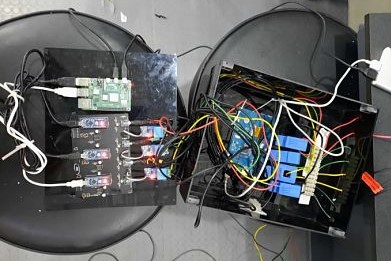
Smart meter technology has revolutionized the power management infrastructure in the world. However, problems such as line theft and high cost of production are still prevalent. There is a need to establish a robust infrastructure through which power management can be done more efficiently. This report presents a possible solution to issues such as the ability to automatically and remotely measure energy usage, detect tampering, monitor power quality, and allow for superior functionality in terms of data communication, metering and control.
AMI is associated with the entire metering facility and the "smart meter" in this infrastructure is the popular metering device. In this infrastructure, the term "smart" makes sense, meaning that the meter can process data (voltage and current) to convert them into useful output information (e.g., energy consumption, power quality indicators, efficiency, and others). But the concept of "smart" is not usually defined because many smart meters have no intelligent functionality on the market. There is a present demand for innovative and smart techniques to give utilities and consumers various kinds of information about their energy consumption, efficiency and costs and therefore better management of energy. Researchers worldwide are therefore proposing new tools, new methods, and innovative ways of saving energy, to provide further information about energy consumption.
Mobile Platform Driver Monitoring and Safety System

Driver’s attentiveness and responsiveness is a critical measure to guarantee a safe environment on the road. The major reason for accidents on the road are drivers’ drowsy and fatigue state which contribute to huge numbers of fatalities and injuries globally. An automated system designed to detect the drowsiness state of the driver and alert him afterwards has a capacity to remarkably reduce accidents. Intrusive methods require a physical contact with the drivers to measure their physiological signals for the signs of drowsiness and previously had comparatively been more accurate in detection. The methodology which we have implemented has eliminated the requirement of being in constant contact with the driver and provides us with even more accuracy due to the utilization of an efficient approach of computer vision and machine learning.
In this project we have developed a mobile platform based driver monitoring and safety system. We have incorporated recent developments that have happened in the field of embedded systems which enables them to handle complex computation and do heavy processing. This allows us to implement machine learning models on small, inexpensive, and powerful standalone systems. In previous solutions for drowsiness detection the approach employs individual techniques which when implemented alone presents practical limitations. Considering this aspect, we in our proposed solution are using above individual techniques in conjunction or hybrid manner but keeping intact the non-intrusive nature of our project. The techniques we are implementing have no such external or environmental factors which can impact the performance of drowsiness detection systems. Our system has no cables requiring physical contact with the driver which in result does not restrict the driver’s movement.
Peer to Peer Energy Trading System
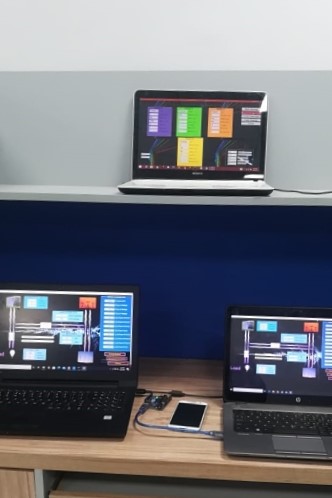
Peer to Peer Energy Trading, commonly referred to as P2P energy trading, is an emerging phenomenon due to the increasing demand in electricity supply and the change in energy supply patterns and technology. As conventional methods of electricity production and supply have been incompetent, newer methods have made its way into the global market. Most notably, two way transfer of energy in the electricity network and independent generation of energy by households. This report proposes a method to employ P2P energy trading within a micro-grid comprising of six houses. A smart bi-directional smart meter designing is discussed along with a GUI comprising of Individual Data Monitor for each house for power agreement between producer and consumer. A Central Power Monitor GUI is also designed to keep track of each consumer’s consumption of energy and producer’s, production of energy taking part in P2P energy trading system. A database is also created to keep past record of data, as well as of present real-time values are also fed to the system.
The main aim of this project is to provide energy in a decentralized network in affordable prices. The energy involved in this project is produced using renewable resources which helps in eradicating greenhouse effect. This also ensures that carbonization is minimized and people from rural as well as from hilly areas are provided with basic necessity of clean electricity in a secure manner. The first step of this project includes designing of a smart meter which is able to read all the essential electrical parameters and track the direction of flow of electricity in both directions. Second step involves, designing of graphical user interface comprising of Individual Data Monitor and Central Server Monitor. Central Server Monitor is used to track the electric parameters of the house that is connected to it while Central Server Monitor keeps track of all the data of the house connected in the P2P network. Finally, the interfacing between the smart meter and the GUIs.
Pick and Place Robotic Arm
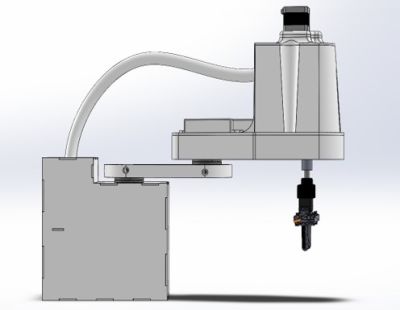
In the generation of ever-increasing demand for higher efficiency and reduced human labor in day-to-day as well as industrial tasks, the focus has veered magnanimously toward robotics. According to International Federation of Robotics (IFR) report of 2020, global population of industrial robots has leaped to 2.7 million, which is 12% increase as compared to last year. One such example of an industrial task that demands increased efficiency is the manual material handling within industry by labor, which places constraints on costs, human energy and speed of packaging. The project focuses on using a Selective Compliance Assembly Robot Arm (SCARA) as an effective alternative to manual material handling procedures, hence introducing automation in the industry. This implies that instead of continuing with the current execution methods by hand and the equivalent transportation of materials via a conveyer belt, a robotic equivalent of a human arm be designed and fabricated resulting in higher levels of efficiency in terms of reduced human error, human energy and labor costs, and an increased packaging rate, throughput and manufacturing productivity.
The aim was to design and fabricate a four-degree-of-freedom robotic arm with an end-effector that can be employed to pick and place finished and unfinished products manufactured in the industry. It uses a Arduino microcontroller board to instruct the robot arm, which can successfully complete the task of picking a series of products one at a time from a conveyor belt and placing them away according to a pre-programmed sequence. Moreover, this project can improve the industry's current material handling technique by introducing low-cost automation.
Research Projects
Development of Intrusion Detection System – MUSTAED®
It was a funded project by National University of Sciences and Technology (NUST), Islamabad. The project funding is Rs 0.48 M. The objective of the project MUSTAED is to develop cost effective Intrusion Detection System for shore installation utilizing expertise held within Pakistan and using commercial off-the-shelf available hardware. MUSTAED V1.0 has been developed and the first working model was installed on site in August 2011. The system was developed using a cost- effective vibration sensor. Lab trials and tests were conducted following “Site Acceptance Trials”. In light of the observations recorded, required modifications were incorporated in the system design and MUSTAED v2.0 was developed for better false alarm rate with lower cost effects.
Development of Face Recognition Under Constrained Environment
One of the many areas in which the lab is striving to gain excellence is local development of security systems. Development of face recognition under constrained software under constrained environment was one of such application. The first phase of the project has been completed. The developed software is capable of recognizing video stream images from a database of 40 images. Efforts are in hand to enhance working capability and efficiency of the software.
Development of Acoustic Signature Analysis
The group worked on a project to upgrade the acoustic signature monitoring system. Efforts are in hand to incorporate classification capabilities. The developed software was required to be capable of recognizing the object generating the underwater sound signals with corresponding confidence level. Moreover, the system provides users/trainees adequate display options to visually identify the contacts and their maneuvering patterns.
Development of Non Intrusive Fault Detection Method for Induction Machine Faults
Fault detection algorithm for the locally developed induction machines is being developed by the group. Faults in electrical circuits and mechanical assembly are being investigated. Classification schemes to differentiate between different types of faults have been achieved. The developed software/hardware provides local manufactures a sophisticated tool which will surely enhance their market competence.
Development of Prognosis Algorithm for Electrical Machines
Prognosis is the logical culmination of diagnosis which is more desirable, lucrative and valuable for the end user. The group is striving to develop a prognosis algorithm for induction. Once developed for induction machines, similar algorithm with required modifications will be developed for different variants of induction machines.
Implementation of Diagnosis and Prognosis Algorithms on FPGA (PSoC)
The group worked on implementation of diagnosis and prognosis algorithms on embedded systems which should be cost effective and easily configurable. The developed hardware comprised a complete solution for fault diagnosis and prognosis for a range of equipment and hardware. It will be working on non intrusive fault detection, classification and prediction doctrine.
Development of Generator Fault Detection Algorithm
Diesel generators have rapidly become an essential part of our country mate’s life, unfortunately due to the existing prolonged electricity crisis. They provide services in all sectors of our daily life. Out of the spectrum of the present energy crisis, generators are also used for a wide variety of requirements. A large number are used by civil and military organizations wherever portability is required. Generators provide power to electric appliances which are used in abundance in all fields of life. Fault free, reliable and safe operation is one of the most desired aspects required by all users. For continued operation of generators, regular maintenance is carried out. Generally Planned Maintenance Schedule (PMS) is performed. PMS compromises maximum useful life and tries to ensure safe operation. On the contrary, condition based maintenance (CBM) approach tries to maximize useful life of equipment without compromising safe operation limits. In this approach, samples of different signals are collected and based on the information extracted from them, deterioration or otherwise in the equipment is estimated. Under the proposed research we will develop a methodology for detection and classification of fault in generator sets which are commonly in service in domestic and industrial applications
Indigenous Development Vibration Analysis (VA) Test
Health state of all the equipment which moves or possess moving parts can be assessed by measuring vibration in the system. If the vibration level increases, it indicates that some part of the equipment is being damaged. Vibration data needs to be collected and is to be analyzed in the time, frequency and/or time frequency domain to detect the abnormality. The vibration measurements are collected using a VA test set. These sets are not produced locally and are imported for large foreign exchange. The project covers engineering aspects of signal processing, data analysis, data acquisition, and customized human machine interface development. It will include development of software, integration of hardware and controls.
Indigenous Development Of SONAR Trainer
The group is working for the indigenous development of sonar trainer. The proposed trainer will comprise of an instructor node and 10 in No student consoles. The instructors will be able to create different scenarios. This will help in educating and training individuals about the actual sonar contacts. The student consoles will be designed in a way that it will appear similar to real sonar display fitted onboard. The project covers engineering aspects of signal processing, data analysis, data acquisition, networking and customized human machine interface development. It will include development of software, integration of hardware and controls.